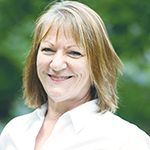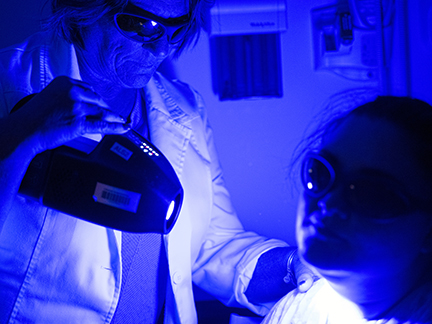By LISA EISENHAUER
When the Sisters of Mercy equipped the forensic nursing team at the congregation-sponsored Mercy Medical Center in Baltimore with a top-of-the-line alternate light source unit about 18 years ago, Debra Holbrook says it put her and the hospital on track to become pioneers in the use of the technology.

Holbrook
Holbrook, the hospital's director of forensic nursing, says the forensic nursing team, which was founded in 1994, was one of the first of its kind in the nation. When the team — officially the Forensic Nurse Examiners Program — began experimenting with the alternate light unit as they examined victims of violence, they found it could be used to detect injuries hidden by skin color and those that left no marks on the surface of the skin.
Holbrook credits that discovery with advancing the work not only of Mercy Medical Center's team, but of forensic nurses everywhere. "This is what changed history in medicine across the world, because I published the very first research ever linking use of alternate light on victims of strangulation to (the ability to see) latent wounds under the skin," she explains.
The study she co-authored with Dr. M. Christine Jackson, medical director of the Forensic Nurse Examiners Program, was published in 2013 in the Journal of Forensic Nursing. It found that of a group of 172 patients of various races who reported being strangled, 93% had no visible evidence of external injuries. However, through use of alternate light, injuries beneath the skin were found in 98% of the patients.

Debra Holbrook, left, director of forensic nursing at Mercy Medical Center in Baltimore, demonstrates the use of an alternate light source device on forensic nurse Allyson Boss. The device emits light in wavelengths that can make wounds below the surface of the skin visible.
Jennifer McMenamin
Holbrook went on to co-author two more studies that have added to a growing body of research that supports the effectiveness of alternate light source technology in documenting violent injuries. She travels the country to educate attorneys, police, judges, clinicians and others on the technology.
She is president-elect of the executive board of the Academy of Forensic Nursing. She has been named a fellow by the American Academy of Nursing, a recognition of her status as a leader in advancing the profession.
Calibrating the tool
Mercy Medical Center continues to take a lead role in research on alternate light source technology. The hospital is collaborating with George Mason University on a rigorous controlled study of the reliability and effectiveness of the technology in identifying bruising and damage not readily visible. "It's a National Institute of Justice-funded study that will standardize what we're doing here at Mercy across the entire United States," Holbrook explains.
In the controlled study, she says injuries like those documented by her team with alternate light sources are being recreated and examined by researchers to make sure the findings match. The full study will probably take another 18 months to complete, but Holbrook says one part that is finished confirmed findings from the strangulation study she co-authored in 2013.
Mercy Medical Center is the designated treatment center for sexual assault and interpersonal violence victims in Baltimore. Its team of about 30 forensic nurses work with criminal justice and other agencies across the city that assist victims of violence. Team members are available 24/7 to examine patients at Mercy Medical Center and other area hospitals and document injuries from assaults, neglect and other maltreatment.
Holbrook says that in addition to conducting evidence-gathering examinations of assault victims at Baltimore-area hospitals, team members are dispatched on similar missions to prisons, nursing homes and military bases, including the U.S. Naval Academy in Annapolis, Maryland.
The forensic nursing team has two large alternate light source units that have a wide range of wavelength settings as well as several small, less expensive units that resemble flashlights and have a more limited wavelength range. All of the units are portable.

Alternate light source technology can enhance the appearance of patterned wounds, like those pictured here from a belt. Alternate light devices can make the wounds visible even weeks after they were inflicted and are no longer able to be seen by the naked eye.
Alternate light source units use lamps that emit visible as well as ultraviolet and infrared color bands, which can't be seen by the naked eye. Those color bands, or wavelengths, enhance the visualization of evidence through fluorescence, which glows; absorption, which darkens; or oblique lighting, which reveals small particles or impressions. Examiners wear goggles, which work as a filter and reveal what had been hidden from view. They document all wounds for potential use as evidence.
Holbrook says the use of alternate light source gives the nurses "another tool in our tool belt, not only for forensic adjudication in a court system, but to provide a lot of information to our medical care providers for their decision-making."
Growing acceptance
When the forensic nursing team first started using alternate light to examine victims of violence and document injuries, Holbrook says the evidence they found faced skepticism from judges and attorneys. "A lot of people challenged us," she says.
Holbrook and her team took it upon themselves to teach people working in the courts, in law enforcement and in the health care sector about the technology. They explained that alternate light source units are like glasses, X-rays or other tools that provide a new way to see things not visible under normal white light.
"Now it's a staple in forensic medical assessment in Baltimore city and we've been able to share this across the world. We're very proud of this coming from Mercy Medical Center," Holbrook says.
While alternate light had forensic applications to gather evidence such as bodily fluids on clothing before Mercy Medical Center's nursing team started using it, Holbrook says it was her team that found and documented its effectiveness in finding injuries hidden beneath the skin.
This type of unseen injury was known to be the norm in strangulation cases when the weapon is the hands, Holbrook says, because choking involves one broad surface, the hands, applying force on another broad surface, the neck. The force of the pressure is so dispersed that the injuries are below the skin, or dermal, level. Those injuries are visible, however, when the patients are examined with alternate light. Holbrook says exactly which wavelength will expose the damage depends on the depth of the injury, skin pigmentation and length of time since the assault.
A study published in 2008 in The Journal of Emergency Medicine showed the risk of homicide increases by 750% for women who are victims of domestic abuse who have been strangled compared to victims who have never been strangled.
Seeking justice
Many patients are referred to the forensic nursing team to help gather evidence of injuries from violent assaults. Holbrook says that the evidence is used in various ways. Some victims pursue an order of protection, some seek criminal prosecution, and some use it to bolster assault complaints in nonjudicial settings, such as at a college.
Sometimes, Holbrook says, her nurses document injuries to domestic abuse victims multiple times before those victims take the forensic findings to the police or before they accept help to change their situation. A victim's reluctance to act is often due to fear of their assailant.
"Justice isn't always in court. What's justice to me might not be justice to my patient," Holbrook says. "So, after we collect our evidence and we do the medical care and treatment of that patient, it's up to patients what they want done with this evidence."
With more research and education efforts supporting alternate light technology as a means to detect hidden injuries, Holbrook says it has gained wide acceptance. As an expert on the technology, she testifies on its reliability and efficacy.
"When I go to court and I sit on the stand and I'm asked, 'Are your peers using this instrumentation?' or 'Is this respected technology within the industry in which you work?' I'm able to say now, 'Absolutely, yes.' And I'm able to name cities that are using this across the United States and across the world," she says.
For more about Mercy Medical Center's forensic nursing team, go to https://www.chausa.org/publications/catholic-health-world/article/august-15-2021/mercy-medical-center-aids-in-baltimores-against-human-trafficking .